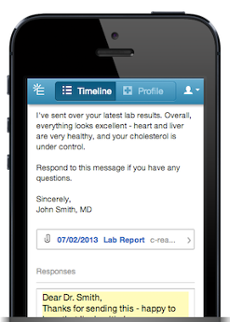Four Ways Elation Passport Improves Patient Satisfaction And Saves Physicians Time

Four Ways Elation Passport Improves Patient Satisfaction And Saves Physicians Time December 6, 2013
 Patient portals are all the rage in health IT. But some physicians have been wary of them, concerned that offering patient portals will only add more uncompensated work to their already unmanageable workload. But patient portals, if done well, can save physicians time and increase patient satisfaction. Elation providers who offer Elation Patient Passport have been able to improve patient satisfaction with little or no additional work for the physician. In fact, Passport eliminates or streamlines many processes in place at physician practices to reduce providers’ workload and give them more time with patients. Here’s how:
Patient portals are all the rage in health IT. But some physicians have been wary of them, concerned that offering patient portals will only add more uncompensated work to their already unmanageable workload. But patient portals, if done well, can save physicians time and increase patient satisfaction. Elation providers who offer Elation Patient Passport have been able to improve patient satisfaction with little or no additional work for the physician. In fact, Passport eliminates or streamlines many processes in place at physician practices to reduce providers’ workload and give them more time with patients. Here’s how:
1) Automatic filing of patient information
Patient Passport automatically files physician-patient communication into the patient’s chart, saving the practice time.
Physicians or their practice staff spend a good chunk of each day on paperwork, whether physical or electronic. For example, when a patient calls, a staff member must transcribe a message about a patient, pull the patient’s chart, and then file the message into the chart—and then repeat the process when the provider responds to the patient. By contrast, Patient Passport is seamlessly integrated into ElationEMR, and all communication with and about patients, from allergies to immunizations, is automatically filed into their charts and made searchable so providers can instantly find the information they need. This automation requires zero effort from physicians and staff, and ensures that relevant patient information is available.
2) Patient education and empowerment
When patients activate their Patient Passport account, they get immediate access to their health information. This educates patients and saves providers time.
With Patient Passport, patients can access all their information in one place, leading to a greater understanding about their health and their physicians’ clinical choices. When patients are on the same page as their physicians, trust increases and outcomes improve.
Patients also can see what information a provider has and how it’s organized, making them more likely to speak up about what’s missing or incorrect in their chart. When patients are educated and can review treatment and advice they get, they can take the right actions to maintain and improve their health — making physicians’ jobs easier.
3) Caregiver access to information
Providers can give seniors’ Patient Passport account information to their children or caregivers, so they can communicate with providers and help manage their parents’ health. All they need is an invite.
Many patients forget a sizable chunk of their interactions with their physicians once they leave the exam room. This has serious health implications, particularly for seniors, given the complexity of their health conditions. At the patient’s request, physicians can sign seniors up for Patient Passport using their childrens’ or caregivers’ email addresses, so they can help manage health information and understand a physician’s recommendations for optimal care. It’s a great way for providers to keep the children of seniors in the loop without the children having to take time off work to participate in their parents’ appointments. It also saves physicians from additional phone calls to children and caregivers that are time-consuming and inefficient.
4) Take control of how you communicate with your patients
Patient Passport lets doctors communicate with patients when and how they need to, replacing ineffective practices and ensuring optimal physician-patient interactions.
An Elation physician recently described to us his pre-Passport way of communicating with patients. He used to call patients every time he needed to relay information to them. It was a direct way to dialog with a patient in real time, but it usually took much longer than expected. Now, in dealing with non-urgent cases, he sends them an e-message, attaches relevant documents like lab results, and explains what the information means and when to follow up. Providers can choose to respond to patients asynchronously through Patient Passport for non-urgent matters, and reserve real-time conversations for high-priority cases. This way, physicians get fewer interruptions in their day because they can respond at will, whether that means immediately or later in the day when they have more time to respond thoughtfully.
Want to learn more about Patient Passport? Check it out here.
